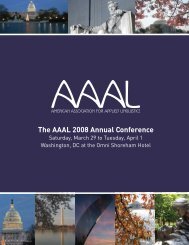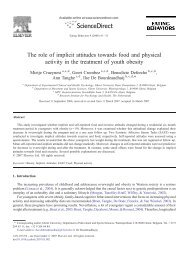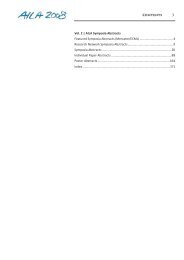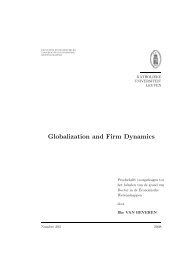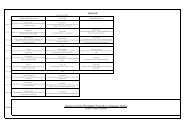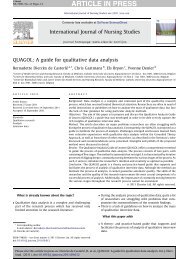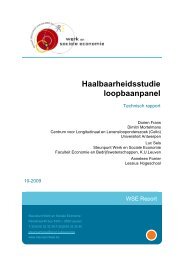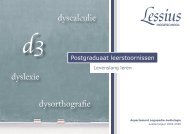View/Open - Lirias@Lessius
View/Open - Lirias@Lessius
View/Open - Lirias@Lessius
You also want an ePaper? Increase the reach of your titles
YUMPU automatically turns print PDFs into web optimized ePapers that Google loves.
Stakeholder Conflicts in Professional Sports. A Case Study in<br />
Professional Road Cycling.<br />
Abstract paper<br />
With respect to understanding stakeholder strategy (the strategy of the stakeholders of the<br />
organization) from the stakeholder‟s perspective, stakeholder literature has traditionally centered<br />
around the structural and demographic approach. The structural approach, on the one hand,<br />
explains stakeholder strategy in terms of the relationship between the organization and the<br />
stakeholder, the demographic approach, on the other hand, explains stakeholder strategy in<br />
terms of stakeholder attributes. Despite recent claims in literature that both approaches<br />
complement each other in explaining stakeholder strategy [Hendry, 2005 – Journal of Business<br />
Ethics 61(1); Frooman and Murrell, 2005 – Business & Society 44(3)], little is known about how<br />
both approaches interact and relate to stakeholder strategy. In this article we draw upon de<br />
Bakker and den Hond‟s suggestion (2008) to integrate the concept of „time‟ in the analysis in<br />
order to gain insights in the interplay of structural and demographic approaches with regard to<br />
stakeholder strategy. We derive through a review of literature, two hypotheses on how changes<br />
in resource dependency and interest intensity (structural and demographic factor, respectively)<br />
relate to changes in stakeholder pathway and stakeholder instrument (two components of the<br />
stakeholder strategy; Frooman, 1999). Consecutively, both hypotheses are tested through an<br />
analysis of six stakeholders‟ strategies deployed during the competition reform in professional<br />
road cycling. Based on interviews and document analysis we confirm that the structural and<br />
demographic approaches are complementary in explaining stakeholder strategy but also that<br />
both approaches relate to different components within a stakeholder strategy. Whereas the<br />
focal organization‟s dependency on the stakeholder explains a stakeholder‟s choice of the initial<br />
pathway (structural factor), changes in this pathway are explained by changes in interest<br />
intensity (demographic factor). This demographic factor also explains changes in stakeholder<br />
instrument. In addition, the data argue in favor of a stakeholder‟s universal tactical starting<br />
position theorized already in stakeholder literature [den Hond and de Bakker, 2007 – Academy<br />
of Management Review 32(3)].<br />
Keywords<br />
Interest intensity<br />
Professional road cycling<br />
Resource dependency<br />
Sport management<br />
Stakeholder attributes<br />
Stakeholder instrument<br />
Stakeholder pathway<br />
Prepaper<br />
Though stakeholder influence has received considerable attention in literature, it is only recently<br />
that a number of studies have started to address the question of stakeholder influence from the<br />
stakeholder perspective (de Bakker and den Hond, 2008). This approach is another step in the<br />
evolution of the stakeholder theory from „a corporate-centric perspective into a more<br />
1
comprehensive theory of the business-society interface‟ (Steurer, 2006: 56). Consequently, few<br />
stakeholder theorists have studied from a stakeholders‟ vantage point the identities (Rowley and<br />
Moldoveanu, 2003), the salience (Mitchell et al., 1997; Rowley, 1997; Frooman, 1999; Neville<br />
and Menguc, 2006), the firm targeting decisions (Rowley and Berman, 2000; Rehbein et al.,<br />
2004; Eesley and Lenox, 2005; Hendry, 2006) and the strategies of stakeholders (Frooman,<br />
1999; Frooman and Murrell, 2005; Hendry, 2005; den Hond and de Bakker, 2007; Zietsma and<br />
Winn, 2008). Frooman (1999: 191) argued that, in contrast to the question of who stakeholders<br />
are and what they want, this latter question of „how‟ they try to obtain salience has received only<br />
piecemeal attention and this despite the fact that stakeholder strategy is „a key element in<br />
stakeholder theory‟.<br />
With respect to explaining stakeholder strategy two approaches are distinguished in stakeholder<br />
literature: a structural vs. a demographic approach (Frooman and Murrell, 2005; de Bakker and<br />
den Hond, 2008). The structural approach, on the one hand, explains stakeholder strategy in<br />
terms of the relationship between the organization and the stakeholder, the demographic<br />
approach, on the other hand, explains stakeholder strategy in terms of stakeholder attributes<br />
(Goodpastor, 1991; Clarkson, 1995; Mitchell et al., 1997; Rowley and Moldoveanu, 2003). In<br />
other words, the structural approach deals with the relational setting of organizations (such as<br />
the level of dependence of the stakeholder on the firm or the centrality of the firm within a<br />
stakeholders‟ network - Rowley, 1997; Frooman, 1999; Frooman and Murrell, 2005) whereas<br />
the demographic approach is all about stakeholder characteristics (such as among others<br />
interest, past experience, identity and ideology of a stakeholder - Rowley and Moldoveanu,<br />
2003; Frooman and Murrell, 2005; den Hond and de Bakker, 2007). Frooman and Murrell (2005:<br />
5) highlight the difference between both approaches using terms of network theory: „instead of<br />
concentrating on demographics (the node), the structural approach is all about relationships (the<br />
tie between the nodes)‟.<br />
This article contributes to stakeholder theory in four ways. First, by focusing on how<br />
stakeholders influence organizations over time – how they act, given they are taking action –<br />
and not on the factors influencing the likelihood stakeholders will mobilize, we take another<br />
approach in stakeholder management (Savage et al., 1991; Frooman, 1999; Hendry, 2005;<br />
Frooman and Murrell, 2005; den Hond and de Bakker, 2007; de Bakker and den Hond, 2008).<br />
Second, this article links changes in structural and demographic factors to changes in<br />
stakeholder pathway and stakeholder instrument. Again, another approach is taken as Frooman<br />
(1999) and Frooman and Murrell (2005) did link structural factors (and not changes in these<br />
factors) to stakeholder strategy (and not to changes in the strategy, nor to changes in the<br />
2
stakeholder pathway or stakeholder instrument). Third, by deriving hypotheses on how changes<br />
in both structural and demographic factors relate to changes in stakeholder pathway and<br />
stakeholder instrument, we add to stakeholder theory. Fourth, by selecting the case of sport<br />
league reform in professional road cycling, we contribute to the literature on stakeholder<br />
strategy in sport management (Holt, 2007; Desbordes 2008; Morrow and Idle, 2008a & 2008b;<br />
Senaux, 2008) which, despite the fact that professional sport is estimated to be the eleventh<br />
largest industry in the United States (Danylchuk et al., 2008), has yet received little attention.<br />
As argued by Hendry (2005) who claimed that an alternative theoretical model on stakeholder<br />
strategy should be grounded in collected data, our findings are based on an analysis of the<br />
strategies deployed by stakeholders since the introduction of the new Union Cycliste<br />
International (UCI) ProTour competition (January 2005) in professional road cycling. There are<br />
three reasons for devoting attention to stakeholder strategies in sport management. First, as<br />
argued by Brewer (2002) and Morrow and Idle (2008b), professional sport is by nature a<br />
representation of conflict in which multiple stakeholders are involved (Dauncey and Hare, 2003).<br />
As such, sport provides an interesting „microcosm‟ that allows researching in detail stakeholder<br />
strategies. Second, the issue of stakeholder strategies within sport management has been<br />
largely left unattended in literature. Whereas Holt (2007) and Senaux (2008) addressed this<br />
issue for football (soccer), it is only recently that the influence of stakeholders in competition<br />
reforms in professional cycling has been addressed (Desbordes 2008; Lagae et al., 2008;<br />
Morrow and Idle, 2008a & 2008b). As such, insights in how stakeholders behave when<br />
reforming sport competitions can be valid for junior and senior management (Parks et al., 2007).<br />
Finally, professional road cycling is not only understudied in comparison to other sports like<br />
baseball, rugby, skiing, snowboarding or soccer (O‟Brien and Slack, 2003; Holt, 2007;<br />
Gammelsaeter and Jakobsen, 2008; Kelly, 2008; Hanstad, 2008; Senaux, 2008; Steen-<br />
Johnsen, 2008), professional road cycling is also characterized by a large and heterogeneous<br />
set of stakeholders with various interest intensities and resource relationships with the focal<br />
organization (Brewer, 2002; Desbordes, 2006; Morrow and Idle, 2008a & 2008b).<br />
The following two-step approach was taken. First, stakeholders - „persons or groups that have,<br />
or claim, ownership, rights or interest in a corporation and its activities, past, present or future‟<br />
(Clarkson, 1995: 106) - have been inventoried through an extensive analysis of various UCI<br />
documents with respect to the establishment of the ProTour competition: UCI correspondence,<br />
minutes of meetings and press releases. The following six stakeholders did emerge out of the<br />
analysis: riders (represented by CPA), ProTour teams (represented by first AIGCP and later on<br />
by IPCT), professional continental teams (teams not granted a ProTour license), G3<br />
3
(representing ASO, RCS and Unipublic which organize the three most important stage races -<br />
Tour, Giro d‟Italia and Vuelta a España, respectively - as well as eight other ProTour races), the<br />
other ProTour races organizers (ProTour16) as well as organizers of non ProTour races. These<br />
various stakeholders will be discussed in more detail at the beginning of the next section. Our<br />
selection of stakeholders therefore extends Morrow and Idle‟s inventory of stakeholders as we<br />
did also include the IPCT, professional continental teams and the ProTour16 as additional<br />
stakeholders (Morrow and Idle, 2008b). Following Morrow and Idle (2008b) and given that the<br />
UCI (the world governing body in cycling) did initiate the new competition in professional road<br />
cycling, the UCI was seen as the focal organization. Second, for each stakeholder, its strategy –<br />
which includes the selection of both pathways (the allies chosen included) and stakeholder<br />
instruments –, its resource dependency and interest intensity towards UCI were inventoried and<br />
analyzed. These components were analyzed for the period January 2005 – July 15 th 2008. This<br />
time period was guided by the following criteria. Whereas January 2005 refers to the start date<br />
of the ProTour licenses for the teams and organizers, mid-July 2008 refers to the UCI<br />
announcement that teams intended not to renew their ProTour licenses for 2009 (UCI, 2008).<br />
For this second phase, the authors relied upon two sources: 17 semi-structured interviews with<br />
representatives of the six stakeholders and a wide variety of written sources: minutes of<br />
meetings, documents provided by the stakeholders, press releases, detailed study of cycling-<br />
specific magazines and internet-based cycling sites such as Cyclingnews.com.<br />
We derive through a review of literature, two hypotheses on how changes in resource<br />
dependency and interest intensity (structural and demographic factor, respectively) relate to<br />
changes in stakeholder pathway and stakeholder instrument (two components of the<br />
stakeholder strategy; Frooman, 1999). Consecutively, both hypotheses are tested through an<br />
analysis of six stakeholders‟ strategies deployed during the competition reform in professional<br />
road cycling. We confirm that the structural and demographic approaches are complementary in<br />
explaining stakeholder strategy but also that both approaches relate to different components<br />
within a stakeholder strategy. Whereas the focal organization‟s dependency on the stakeholder<br />
explains a stakeholder‟s choice of the initial pathway (structural factor), changes in this pathway<br />
are explained by changes in interest intensity (demographic factor). This demographic factor<br />
also explains changes in stakeholder instrument. In addition, the data argue in favor of a<br />
stakeholder‟s universal tactical starting position theorized already in stakeholder literature [den<br />
Hond and de Bakker, 2007 – Academy of Management Review 32(3)].<br />
References<br />
4
Brewer, B.D.: 2002. „Commercialization in Professional Cycling 1950-2001: Institutional Transformations<br />
and the Rationalization of “Doping”, Sociology of Sport Journal, 19(3), 276-301.<br />
Clarkson, M.B.E.: 1995, „A Stakeholder Framework for Analyzing and Evaluating Corporate Social<br />
Performance‟, Academy of Management Review 20(1), 92-117.<br />
Danylchuk, K.E., A. Doherty, M. Nicholson and B. Stewart: 2008, „International Sport Management:<br />
Creating an International Learning and Teaching Community‟, International Journal of Sport<br />
Management and Marketing 4(2/3), 125-145.<br />
Dauncey, H. and G. Hare: 2003, The Tour de France, 1903-2003: a Century of Sporting Structures.<br />
Meanings and Values, (Frank Cass, London).<br />
De Bakker, F.G.A. and F. den Hond: 2008, „Introducing the Politics of Stakeholder Influence‟, Business &<br />
Society 47(1), 8-20.<br />
Den Hond, F. and F.G.A. de Bakker: 2007, „Ideologically Motivated Activism: How Activist Groups<br />
influence Corporate Social Change Activities‟, Academy of Management Review 32(3), 901-924.<br />
Desbordes, M.: 2008, „The Future of the Tour de France: from an Independent Style of Organization to “A<br />
Formula One Model?‟, in D. Arthur and S. Chadwick (eds.), International Cases in the Business of Sport,<br />
(Butterworth-Heinemann, Oxford), pp. 358-371.<br />
Eesley, C. and M.J. Lenox: 2005. „Secondary Stakeholder Actions and the Selection of Firm Targets‟<br />
(working paper), Fuqua School of Business, Duke University.<br />
Frooman, J. and A.J. Murrell: 2005, „Stakeholder Influence Strategies: the Roles of Structural and<br />
Demographic determinants‟, Business & Society 44(3), 3-31.<br />
Frooman, J.: 1999, „Stakeholder Influence Strategies‟, Academy of Management Review 24(2), 191-205.<br />
Gammelsaeter, H. and S.-E Jakobsen: 2008, „Models of Organization in Norwegian Professional Soccer‟,<br />
European Sport Management Quarterly, 8(1), 1-25.<br />
Goodpastor, K.: 1991, „Business Ethics and Stakeholder Analysis‟, Business Ethics Quarterly 1(1), 53-71.<br />
Hanstad, D.V.: 2008, „Drug Scandal and Organizational Change within the International Ski Federation: A<br />
Figurational Approach‟, European Sport Management Quarterly, 8(4), 379-398.<br />
Hendry, J.R.: 2005, „Stakeholder Influence Strategies: an Empirical Exploration‟, Journal of Business<br />
Ethics 61(1), 79-99.<br />
Hendry, J.R.: 2006, „Taking Aim at Business: What Factors lead Environmental Non-governmental<br />
Organizations to Target Particular Firms‟, Business & Society 45(1), 47-86.<br />
Holt, M.: 2007, „The Ownership and Control of Elite Club Competition in European Football‟, Soccer and<br />
Society 8(1), 50-67.<br />
Kelly, S.: 2008, „Understanding the Role of the Football Manager in Britain and Ireland: A Weberian<br />
Approach‟, European Sport Management Quarterley, 8(4), 399-420.<br />
Lagae, W., T. Benijts, B. Vanreusel and B. Vanclooster: 2008, „Spectator Sports as a Representation of<br />
Conflict. The Case of Stakeholders‟ Conflicts in Professional Cycling‟, Book of Abstracts 16 th EASM<br />
European Sport Management Conference (Heidelberg/Bayreuth), pp.114-116.<br />
Mitchell, R.K., B.R. Agle and D.J. Wood: 1997, „Toward a Theory of Stakeholder Indentification and<br />
Salience: Defining the Principle of Who and What really Counts, Academy of Management Review 22(4),<br />
853-886.<br />
Morrow, S. and C. Idle: 2008a, „The Challenges of Modernizing a Professional Sport: a Case Study in<br />
Professional Road Cycling‟, in D. Arthur and S. Chadwick (eds.), International Cases in the Business of<br />
Sport, (Butterworth-Heinemann, Oxford), pp. 45-59.<br />
Morrow, S. and C. Idle: 2008b, „Understanding Change in Professional Road Cycling‟, European Sport<br />
Management Quarterly, 8(4), 315-335.<br />
Neville, B.A. and B. Menguc: 2006, „Stakeholder Multiplicity: Toward an Understanding of The Interactions<br />
Between Stakeholders‟, Journal of Business Ethics 66(4), 377-391.<br />
O‟Brien, D. and T. Slack: 2003, „An Analysis of Change in an Organizational field: the Professionalization<br />
of English Rugby Union‟, Journal of Sport Management 17(4), 417-448.<br />
Parks, J.B., J. Quarterman and L. Thibault: 2007, Contemporary sport management (3 rd edition), (Human<br />
Kinetics, Champaign).<br />
Rehbein, K., S. Waddock and S.B. Graves: 2004, „Understanding Shareholder Activism: which<br />
Corporations are Targetted‟, Business & Society 43(3), 239-258.<br />
Rowley, T.J. and M. Moldoveanu: 2003, „When Will Stakeholder Group Act? An Interest- and Indentity<br />
Based Model of Stakeholder Group Mobilization, Academy of Management Review 28(2), 204-219.<br />
5
Rowley, T.J. and S. Berman: 2000, „A Brand New Brand of Corporate Social Performance‟, Business &<br />
Society 39(4), 397-418.<br />
Rowley, T.J.: 1997, „Moving Beyond Dyadic Ties: a Network Theory of Stakeholder Influences‟, Academy<br />
of Management Review 22(4), 887-910.<br />
Savage, G., T. Nix, C. Whitehead and J. Blair: 1991, „Strategies for Assessing and Managing<br />
Stakeholders‟, Academy of Management Review 5(2), 61-75.<br />
Senaux, B.: 2008, „A stakeholder Approach to Football Club Governance‟, International Journal of Sport<br />
Management and Marketing 4, 4-17.<br />
Steen-Johnsen, K.: 2008, „Networks and the Organization of Identity: the Case of Norwegian<br />
Snowboarding‟, European Sport Management Quarterly, 8(4), 337-358.<br />
Steurer, R.: 2006, „Mapping Stakeholder Theory Anew: From the Stakeholder Theory of the Firm to three<br />
Perspectives on Business-society Relations‟, Business Strategy and the Environment 15(1), 55-69.<br />
Zietsma, C. and M.I. Winn: 2008, „Building Chains and Directing Flows‟, Business & Society 47(1), 68-101.<br />
6




